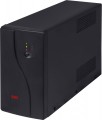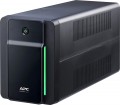Full load operating time
UPS continuous operation time from a fully charged battery when connected to a load with a power equal to the UPS output power (maximum or effective, depending on the type of load, see the relevant paragraphs for details). For a UPS designed to work with a home or office PC, a time of about 10-15 minutes is considered sufficient, this is enough to save data and complete work. To power servers, it is worth using devices with an operating time
of 20 minutes or more.
Half load operating time
UPS continuous operation time from a fully charged battery when connected to a load with a power equal to half the output power of the UPS (maximum or effective, depending on the type of load, see below for details). The operating time with such a load is much longer than for a full load, and even in the simplest models it can reach 20-30 minutes.
Switching to battery
The time required to transfer the load from mains power to battery power. In standby and
interactive UPSs (see Type), a short-term power failure occurs at this moment — accordingly, the shorter the time to switch to the battery, the more uniform the power supply is provided by the source during a power failure. Ideally, the switching time for the traditional 50 Hz AC frequency should be less than 5 ms (a quarter of one cycle of the sine wave). With inverter UPSs, the transfer time is, by definition, zero.
Input voltage range
In this case, the input voltage range is implied, in which the UPS is able to supply a stable voltage to the load only due to its own regulators, without switching to the battery. For redundant UPSs (see "Type") this range is quite small, approximately 190 to 260 V; for interactive and especially inverter ones, it is much wider. Some UPS models allow you to manually set the input voltage range.
Max. current
The maximum current drawn by the UPS. In fact, the current reaches its maximum value only when the UPS is operating from the mains with maximum load power and a completely discharged battery. However, when calculating the load on the power grid, this parameter should be taken into account.
1st battery voltage
The value of the operating voltage of one complete battery. In most cases, it is 12 V, UPS with 24-volt batteries is a little less common.
Battery type
The type of battery installed in the UPS.
—
Fiberglass (AGM). An advanced type of lead-acid battery with electrolyte in an adsorbed state: the compartments of such a battery are filled with porous material, which contains acid. At the same time, the battery case is sealed and AGM models are maintenance-free. This technology is the most popular in batteries for uninterruptible power supplies: it is ideal for batteries operating in buffer mode (that is, when they rarely need to be discharged and, as a rule, little by little). In addition, it provides a long service life, and AGM batteries are inexpensive. The disadvantages of this option include the impossibility of replenishing the electrolyte if it leaks, as well as poor tolerance to overcharging (although the latter becomes irrelevant with a high-quality power controller).
—
Gel (GEL). A type of lead-acid battery that uses a gel electrolyte. GEL batteries are best suited for operation in cyclic mode - that is, when the battery needs to power the load for a long time, discharge almost to zero, then charge and again provide long-term autonomous power. But for the buffer mode, in which most UPSs operate (standing on standby for a long time in order to briefly maintain power supply in the event of a failure), this technology is not suitable for a number of reasons. Therefore, it makes sense to purchase such batteries only in cases where t
...he “uninterruptible power supply” has to be turned on almost every day - for example, in unstable networks with constant and long-term power outages.
— Lithium-ion (Li-Ion). The key advantages of lithium-ion batteries are high capacity with small dimensions and weight. Also, Li-Ion batteries are not subject to the “memory effect” and can charge quite quickly. Of course, this option is not without its drawbacks - first of all, it is sensitive to low and high temperatures, and if overloaded, the lithium-ion battery can catch fire or even explode. However, thanks to the use of built-in controllers, the likelihood of such “emergency” situations is extremely low and, in general, the advantages of this technology significantly outweigh the disadvantages.
— Lithium iron phosphate (LiFePO4). An advanced modification of lithium-ion batteries (see above), designed to eliminate some of the shortcomings of the original technology. Lithium iron phosphate batteries are characterized by a large number of charge/discharge cycles, chemical and thermal stability, low temperature tolerance, short charging time (including high currents) and safety in operation. The likelihood of an “explosion” of a LiFePO4 battery when overloaded is reduced to almost zero, and in general, such batteries cope with high peak loads without problems and maintain the operating voltage almost until they are fully discharged.Cold start
The ability to turn on the uninterruptible power supply in the "cold start" mode.
A
cold start is a turn-on mode in which there is no external power, and the load connected to the UPS is powered immediately from the uninterruptible battery (which, of course, must be charged). This mode is especially useful in emergency cases — for example, if you urgently need to print a document, but there is no light.
Fuse
Fuses are used to protect the UPS from a critical increase in current strength: at the right time, they open the circuit, preventing unpleasant consequences. Today, these types of fuses are used.
— Melting. At a critical current strength, the conductive element in such a fuse melts and opens the circuit. The fusible protection is disposable, after operation such a fuse must be replaced.
— Automatic. Such a fuse has a sensor that monitors the current strength and opens the contacts at the right time. Its main difference from fusible is reusability: after operation, the circuit can be closed again with literally one press of the button on the fuse.

